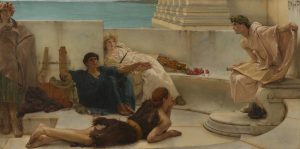Thanks for listening! Check out The Last Days of Pompeii. What a wonderful, mad book with a description of Glacus’ house based on the House of the Tragic Poet. There is a great blog posting from the Getty about the book.
Because none of the Pompeian interiors from houses in New York City survives, one has to go look for them in older publications – so George Sheldon’s book – is a good place to start for J. P. Morgan’s interiors.
The Greco-Pompeian Room, Henry G. Marquand’s Mansion
The furniture and paintings from this room survive, even if the house does not. The piano is now in the collection of the Clark Institute, which also hosted an exhibition about the whole room. Lawrence Alma-Tadema, the famed Anglo-Dutch painter, designed the room and painted A Reading from Homer, which is lovely historical painting.
Bibliography:
Bulwer-Lytton, Edward. The Last Days of Pompeii. London: Richard Bentley, 1834.
Gardner Coates, Victoria, Kenneth D. S. Lapatin, and Jon L. Seydl. The Last Days of Pompeii: Decadence, Apocalypse, Resurrection. Los Angeles: J. Paul Getty Museum, 2012.
Nichols, Marden. “Domestic Interiors, National Concerns: The Pompeian Style in the United States.” In Housing the New Romans: Architectural Reception and Classical Style in the Modern World, edited by Katharine von Stackelberg and Elizabeth Macaulay-Lewis, 126–53. New York: Oxford University Press, 2017.
Morris, Kathleen M. and Alexis Goodin, eds. Orchestrating Elegance: Alma-Tadema and the Marquand Music Room, Williamstown, MA: Clark Institute, 2017.
Sheldon, George William. Artistic Houses: Being a Series of Interior Views of a Number of the Most Beautiful and Celebrated Homes in the United States : With a Description of the Art Treasures Contained Therein. New York: Printed for the subscribers by D. Appleton and Company, 1883.



